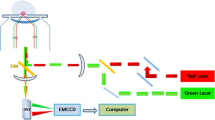Abstract
A rapid bioassay is described based on the detection of colocalized fluorescent DNA probes bound to DNA targets in a pressure-driven solution flowing through a planar microfluidic channel. By employing total internal reflection excitation of the fluorescent probes and illumination of almost the entire flow channel, single fluorescent molecules can be efficiently detected leading to the rapid analysis of nearly the entire solution flowed through the device. Cross-correlation between images obtained from two spectrally distinct probes is used to determine the target concentration and efficiently reduces the number of false positives. The rapid analysis of DNA targets in the low pM range in less than a minute is demonstrated.




Similar content being viewed by others
References
Fitch JP, Raber E, Imbro DR (2003) Science 302:1350
Shendure J, Mitra RD, Varma C, Church GM (2004) Nat Rev Genetics 5:335
Patton WF (2002) J Chromatogr B 771:3
Rao RS, Visuri SR, McBride MT, Albala JS, Matthews DL, Coleman MA (2004) J Proteome Res 3:736
Nolan RL, Cai H, Nolan JP, Goodwin PM (2003) Anal Chem 75:6236
Trabesinger W, Schutz GJ, Gruber HJ, Schindler H, Schmidt T (1999) Anal Chem 71:279
Moerner WE, Kador L (1989) Phys Rev Lett 62:2535
Moerner WE, Orrit M (1999) Science 283:1670
Betzig E, Chichester RJ (1993) Science 262:1422
Moerner WE, Fromm DP (2003) Rev Sci Instrum 74:3597
Ambrose WP, Goodwin PM, Nolan JP (1999) Cytometry 36:224
Trabesinger W, Hecht B, Wild UP, Schutz GJ, Schindler H, Schmidt T (2001) Anal Chem 73:1100
Hess ST, Huang SH, Heikal AA, Webb WW (2002) Biochemistry 41:697–705
Medina MA, Schwille P (2002) Bioessays 24:758
Rarbach M, Kettling U, Koltermann A, Eigen M (2001) Methods 24:104
Laurence TA, Kapanidis AN, Kong XX, Chemla DS, Weiss S (2004) J Phys Chem B 108:3051
Hollars CW, Lane SM, Huser T (2003) Chem Phys Lett 370:393
Bieschke J, Giese A, Schulz-Schaeffer W, Zerr I, Poser S, Eigen M, Kretzschmar H (2000) Proc Natl Acad Sci USA 97:5468
Ma YF, Shortreed MR, Yeung ES (2000) 72:4640
Axelrod D (1981) J Cell Bio 89:141
Sawhney AS, Hubbell JA (1992) Biomaterials 13:863
Bearinger JP, Voros J, Hubbell JA, Textor M (2003) Biotechnol Bioeng 82:465
Elbert DL, Hubbell JA (1998) J Biomed Mater Res 42:55
Kenausis GL, Voros J, Elbert DL, Huang NP, Hofer R, Ruiz-Taylor L, Textor M, Hubbell JA, Spencer ND (2000) J Phys Chem B 104:3298
Acknowledgements
This work was performed under the auspices of the US Department of Energy by the University of California, Lawrence Livermore National Laboratory under contract number W-7405-Eng-48. This research was funded by the Exploratory Research-Laboratory Directed Research and Development Program at Lawrence Livermore National Laboratory. We would like to thank Jane Bearinger (LLNL) and Stephanie Pasche (ETH Zurich) for graciously providing PLL-g-PEG used in these experiments.
Author information
Authors and Affiliations
Corresponding author
Rights and permissions
About this article
Cite this article
Hollars, C.W., Puls, J., Bakajin, O. et al. Bio-assay based on single molecule fluorescence detection in microfluidic channels. Anal Bioanal Chem 385, 1384–1388 (2006). https://doi.org/10.1007/s00216-006-0561-8
Received:
Revised:
Accepted:
Published:
Issue Date:
DOI: https://doi.org/10.1007/s00216-006-0561-8




